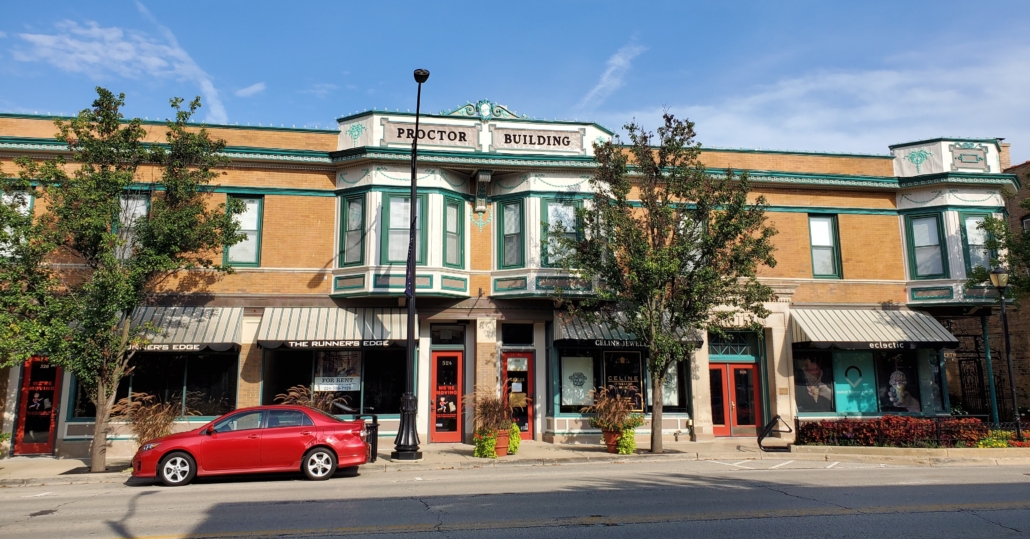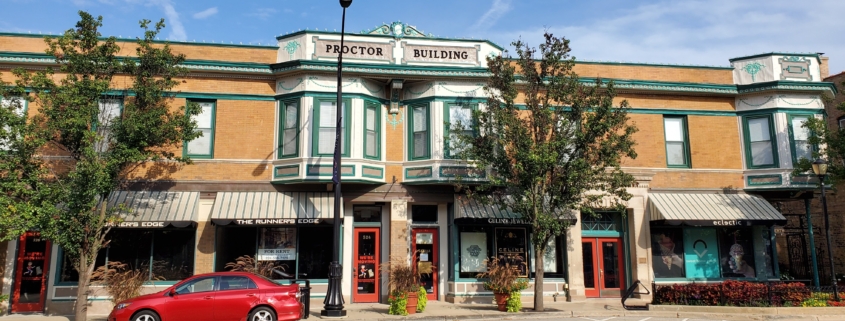Proctor Building

Proctor Building located in downtown Libertyville, IL
Proctor Building in Libertyville
The Proctor Building in Libertyville is one of many structures that were part of the building boom following the Libertyville fire of 1895. The fire destroyed many of the frame buildings that occupied the east side of Milwaukee Avenue, including the Grove Hotel (circa 1860). Built in 1903, the Proctor Building is one of several Libertyville buildings listed on the National Register of Historic Places.
Proctor Building Architecture
The Proctor Building was built by brothers Robert, Charles, and Richard Proctor and their cousin Elisha Proctor. They were members of Lake County Gravel Company, the earliest land syndicate in the area and formed in 1892. They envisioned a large multi-use commercial structure on the site of the former Grove Hotel. Chicago architect William G. Krieg (1874-1944), designed the building in a late 19th and 20th-century revival style.
Extending 110’-6” feet along Milwaukee Avenue, the new two-story structure housed retail businesses on the street level and the New Castle Hotel above. The building had “modern” conveniences such as steam heat, gas from a private gas plant, and hot and cold running water. At the time it was built, the New Castle Hotel was the largest of the three hotels in Libertyville.
The Lake County Independent described the Proctor Building as “Libertyville’s first metropolitan building, the pride of all citizens.”
Although the New Castle Hotel closed in 1947 and the building was remodeled and expanded several times, much of the original structure remains. According to the 2016 application for Libertyville historic preservation landmark designation, “The hotel entrance is intact along with the original vestibule and stairway to the second floor. The hallways on the second floor are virtually unchanged except for the 1932 addition to the back of the building.”
Take a walk down Milwaukee Avenue to see the handsome brick building, accented with wood and stone trim. The first floor looks very open and airy, with large display windows suitable for retail businesses. The second floor features large ornamental bay windows to admit light and views for the original hotel rooms, which are now apartments. Notice how the street entrances are slightly recessed. The former hotel entrance is positioned in the center of the front façade and it is boldly framed in decorative limestone.
Proctor Building Resources
It’s fun to discover the history of our local buildings! Intrigued? You can see the Proctor Building floor plan and learn more about the building in the 2016 application for Libertyville historic preservation landmark designation.
The Illinois Digital Archives is another amazing source of information with great old photos of Libertyville and the Proctor Building. Scroll down on this page to the photos labeled “Factor’s” to see the building in 1957.
Did You Know?
The south façade of the Proctor Building faces onto the Liberty Walk. At one time, the owner of the Proctor Building expanded the building into the Liberty Walk, closing off access from Milwaukee Avenue to the parking lot behind the building. In the winter of 1997, the new building owners removed the brick walls and roof of the addition to restore the access. You can still see a remnant of the Proctor Building addition – look for the steel beams which supported the roof.
The first-floor addition closing the Liberty Walk is clearly shown in this photo from the Libertyville-Mundelein Historical Society collections of the Cook Memorial Public Library District.
5 Facts We Didn’t Know
- What Happened to Libertyville’s First Hotel? – We learned that Libertyville’s first hotel, The Grove Hotel, was built in 1840. It was dynamited during the fire of 1895 to save the neighboring Methodist Church!
- After the 1895 Fire, Fireproof Was a Big Deal – The Proctor Building was considered to be a real asset to the town and was described as “practically fireproof”! Following the fire, all downtown structures were required to be brick.
- Where the 1895 Fire May Have Started – Although we don’t know how the 1895 fire was started, it was first spotted at the back of Schanck’s Hardware at the corner of Cook Street and Milwaukee Avenue.
- Church Street Had a Different Name – Church Street (where our office and St. Lawrence Episcopal Church are located) was originally known as “Orchard Street”.
- Roads and Train Lines – The Village of Libertyville grew in large part because it was accessible by roads and train lines. Freight and passenger rail access came to the town in 1880. In 1903, the year the Proctor Building was built, an electric rail line opened on the south end of town (now the North Shore bike path).



